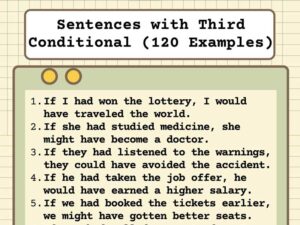11 Rules of Subject Verb Agreement with Examples
What is Subject Verb Agreement?
Subject verb agreement is a structure where the verb is similar to the subject in terms of figure. There are certain rules to use the subject and verb in a sentence in a number of ways. All these rules are explained here with the help of examples.
Usually a sentence consists of two parts.
- Subject
- Verb
Subject
It exposes what the sentence is about. It can be a noun or a pronoun. It may be singular or plural.
Books, Alice, car etc. are examples of nouns.
Verb
It expresses the action of a sentence. For example, is, will, have taken, etc.
How to make subject and verb agree?
- Find the subject of the sentence.
- Make sure, if the subject is singular or plural, and
- Decide which form of the verb will match the subject.
Examples
Here are some examples
- I (subject) do not understand (verb) the paper.
- These shoes are too big.
- Something (subject) is (verb) wrong with me.
- Alice is going to school.
- Amna and Sara are playing together.
In above sentences the subject and verbs are shown bold.
Rules of Subject Verb Agreement with Examples
Rules of subject verb agreement are explained here with the help of examples. We have described 11 rules here.
- Singular and plural verbs
- Singular and plural subjects
- Midsentence phrase or clause
- Singular and plural indefinite pronoun
- Collective nouns
- Pair nouns
- Use of either – or
- Use of neither – nor
- Fractional expressions
- Relative pronoun
- Compound subjects
1 – Singular and plural verbs
Verb must agree with subjects in figures and in person. If the subject is singular, the verb must be singular, for example,
The dog drinks water every day.
In this sentence, the ‘dog’ is a singular subject, and ‘drinks’ show singular verb.
Now, on the other hand, see this example,
Dogs drink water every day.
In this sentence ‘dogs’ is a plural subject and ‘drink’ is singular. Here, plural subject is used with a singular verb.
In present tense
| Singular | Plural |
| The door is broken. | The doors are broken. |
| The book looks nice. | The books look nice. |
| The boy runs. | The boys run. |
| She plays. | They play. |
Now, we see the examples using past tense.
| Singular | Plural |
| The door was broken. | The doors were broken. |
| The book looked nice. | The books looked nice. |
| The glass was damaged. | The glasses were damaged. |
2 – Singular and plural subjects
Two or more words connected by ‘and’ take a plural verb.
Sana and Sara are playing together.
Now, see another example,
Bread and butter was so delicious.
In this sentence, we use singular verb because “bread and butter” expresses a singular thing.
Words of measurement takes a singular verb.
- Fifteen miles is too far away.
- Twenty pounds seems a normal weight of a child.
Titles and names also take a singular verb.
Jon Keats was famous poet.
3 – Mid-sentence phrase or clause
Subject verb agreement with a phrase or clause between the subject and verb.
These examples will show you that in some sentences, there is a singular verb, and in some sentences, there are plural verbs.
Examples
- The house between the two streets is empty.
- The kitchen has all spices-boxes.
- The boxes of the cake are on the table.
4 – Singular and plural indefinite pronoun
Singular indefinite pronouns examples
In these sentences singular verb is used with singular indefinite pronouns.
- Something is wrong with me.
- Everybody enjoys a wedding ceremony.
- Anybody is more attractive than you.
Plural indefinite pronouns
In these sentences plural verb is used with plural indefinite pronouns.
- Both are qualified for the interview.
- Most of the apples were eaten.
- Few are already on the island.
Read also: Figures of Speech Definition & Examples
5 – Collective nouns
It is also called a group noun. It expresses a group of people such as family, army, team etc. It can be singular or plural depending upon the meaning.
Examples
- The crowd is in a happy mood. (singular)
- The staff have gone. (plural)
In some situations, we use a singular verb with ‘it’, ‘its’ and ‘which’; and plural verb with ‘they’, ‘their’ and ‘who’.
Examples
- This politician wants to improve its progress.
- The crowd who have gathered here are in a happy mood.
Example of whole group
- The class consists of twenty five students.
6 – Pair nouns
A pair noun is always plural and takes a plural verb.
Examples
- Your new pants are very nice.
- Those shirts are neat and clean.
Here, we use a pair noun for something that has two parts. Pant consists of two parts (left and right leg) and the shirt also consists of two parts (like sleeve – left and right).
It is also used for glasses and scissors.
Example
Those scissors are not good in quality.
7 – Use of either-or in a phrase
It is used before subjects, sometimes it takes a singular verb and sometimes a plural verb.
Examples
- Either my father or my brothers are going to the office.
- Either a teacher or the students are in a classroom to study.
- Either blue or white is my favorite color.
- We met for a reason, either you are a blessing or a lesson. (In this sentence ‘we’ is subject and we use ‘either-or’ in the last part)
- Is either my father or brothers are responsible for this act? (Sometimes ‘either-or’ is used with interrogative sentences)
8 – Use of neither-nor in a phrase
It can be used both singular as well as plural in sentences.
Examples
- Neither my mother nor my sisters know how to swim.
- Neither my father nor my mother is coming to play.
- Neither Bob nor his brother is going to college.
9 – Fractional expressions
Fractional expressions are sometimes singular and sometimes plural. It also depends on its meaning how it represents such as half of, a part of, a percentage of, etc.
Majority of sentences are in plural form.
Examples
- Four and four is eight.
- Forty percent of the student body is in favor of change the syllabus.
- Some of the visitors are angry.
- Three-fifths of the swords were lost in battle.
10 – Relative pronoun
Relative pronouns (who, which, or that) can be singular or plural.
Examples
- Alice is one of the students who has done her work.
- Pulses that contain vitamins are helpful to maintain the physical condition.
- A pen which has lid is more beautiful.
11 – Compound subjects
Compound subjects (two subjects) always take a plural verb. In some situations, it may be singular.
Examples
- Sugar and salt are needed.
- Sara and Hira are going together.
- The director and producer is arriving soon. (in this sentence director and producer refers to the same person)
- The department members and chairman have decided to teach every student.
Further Reading:








I like this and found it useful.
We are glad you found it helpful.
Interesting stuff to read. Keep it up.